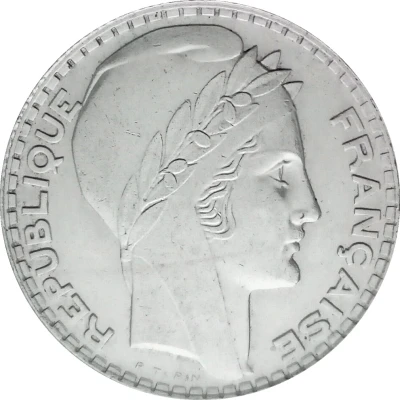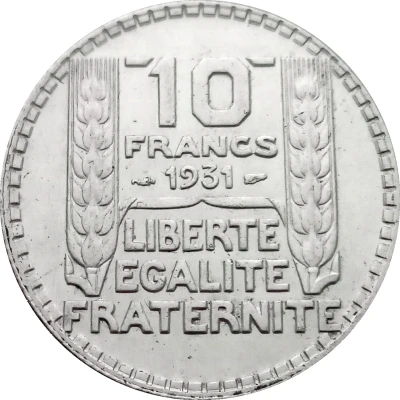


© CGB
10 Francs pattern of Turin
1929 year| Aluminium bronze | 8.94 g | 27.84 mm |
| Issuer | France |
|---|---|
| Period | Third Republic (1870-1940) |
| Type | Pattern |
| Year | 1929 |
| Value | 10 Francs |
| Currency | Franc (1795-1959) |
| Composition | Aluminium bronze |
| Weight | 8.94 g |
| Diameter | 27.84 mm |
| Shape | Round |
| Technique | Milled |
| Orientation | Coin alignment ↑↓ |
| Demonetized | Yes |
| Updated | 2024-10-04 |
| Numista | N#166473 |
|---|---|
| Rarity index | 91% |
Reverse
10 / FRANCS / 1929 / FREEDOM / EQUALITY / FRATERNITY / TRIAL Between two vertical ears of wheat, face and year, framed by the different, in three lines, separated from the republican triad, also in three lines, by two leaves of the ears of wheat joining together
Script: Latin
Lettering: 10 / FRANCS / 1929 / LIBERTE / EGALITE / FRATERNITE / ESSAI
Edge
Reeded
Comment
10 examples have been discovered, shifted to 5.5 o'clock, in a way that is incomprehensible for an assay. However, it seems that all monetary tests of this type were struck with the corner axis at 6 o'clock.On these 10 off-axis and 11 non-off-axis examples, I carried out a weight test, and here are the results:
Off-axis examples weigh between 8.69 g and 8.94 g (weight range 0.25 g).
-Normal specimens weigh between 8.57 g and 9 g (range 0.43 g)
The normal specimens appear to have a greater weight range than the off-axis specimens, which may indicate that greater care was taken in selecting the blanks for the latter.
The difference is almost 2-fold!
In any case, there's nothing about this in the reference books.
This test was adopted in silver and bears the number F. 360 in Le Franc.
Interesting fact
The Pattern 10 Francs coin was designed by French sculptor and engraver, Paul-Albert Bartholomé. Bartholomé was a prominent artist during the late 19th and early 20th centuries, and his work can be found in various museums and collections around the world. The Pattern 10 Francs coin features a portrait of a young woman on the obverse side, which was a common theme in Bartholomé's work. The reverse side of the coin depicts a stylized image of a tree, which symbolizes strength and growth. The coin's design was meant to represent the values of the French Republic, such as liberty, equality, and fraternity.



